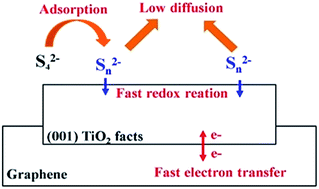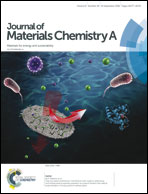Promoting polysulfide redox reactions and improving electronic conductivity in lithium–sulfur batteries via hierarchical cathode materials of graphene-wrapped porous TiO2 microspheres with exposed (001) facets†
Abstract
High-performance lithium–sulfur cells are one of the most important candidates for next-generation rechargeable batteries due to their high energy density and low cost. However, the polysulfide shuttle reaction and low conductivity sulfur cathode limit their engineering applications. Herein, this study presents a facile method to prepare self-assembled composites of porous TiO2 with exposed (001) facets wrapped in graphene sheets for overcoming both obstacles at once. The highly oriented graphene encapsulates the TiO2 microspheres completely, and this composited structure not only reveals that the TiO2 with (001) facets can provide strong adsorption to accelerate polysulfide redox reactions via interfacial activation of Ti sites, but also generates sufficient electrical contact for promoting cell performance under high sulfur loading conditions. As a result, the electrodes (area: 2 cm2) with 3.2 and 2.3 mg cm−2 sulfur loading possess high initial cell capacities of 1100 and 1200 mA h g−1, and retain 700 and 870 mA h g−1 after 200 cycles under 5.2 mA, respectively. During long term cycling, the cell retains 583 mA h g−1 after 600 cycles at 5.2 mA with 1.8 mg cm−2 sulfur loading.



 Please wait while we load your content...
Please wait while we load your content...